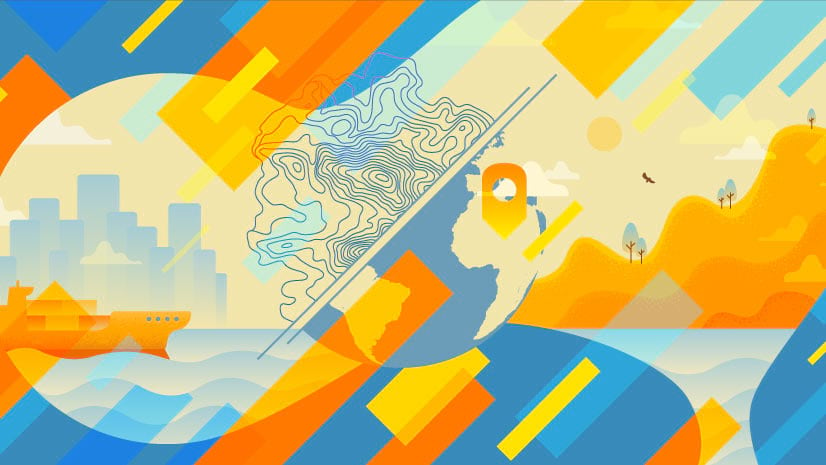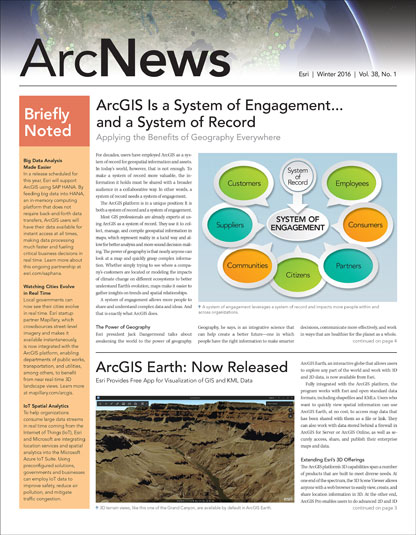The Relevance of Cartography: A Cartographer’s Perspective
Travel is part of life as president of the International Cartographic Association (ICA). The purpose is usually to participate in workshops, seminars, conferences, and business meetings.
Unsurprisingly, maps play an important role in all of this—and not just the ones I talk about during meetings. I also have to use maps to get to my destination and find my way around locally.
In preparing for a trip, an interesting pattern emerges: Following what is essentially computer science professor Ben Shneiderman’s visual information-seeking mantra, I—like many people—tend to look at an overview of the place first, then zoom in and filter out the information I don’t need, and then dive into the details. For example, if I were to visit a new place for the first time—say, Redlands, California, as a not-so-arbitrary example—I might first pick up an atlas to try to get a rough idea of which country and region or state it is in. Getting more focused, my research would take me to Southern California. Then, the details might reveal the exact address I am set to visit. This is the process of orienting oneself to a place.
Some people, however, might find it more expedient to skip the first two steps and zoom directly into the point of interest. Using interactive mapping tools, they can find nearly every location in the world. And with voice navigation, they can be guided to exactly where they need to go—no map even needed.
While some could argue that maps are like cars—as long as they drive, there’s no need to learn about the engine—blindly following navigation systems has a mind-numbing effect. What if I don’t know how far east Redlands is from Los Angeles or whether it is north or south of San Diego? Would this affect anything? My (only slightly biased) answer is yes. That is because maps give context.
Of course, navigation systems have made traveling much easier, especially on the local level in unknown cities. I love to use and even experiment with them. They always tell me where I am, and everything runs smoothly—as long the maps are up to date and the device’s battery does not die.
If the device does run out of battery, though, paper maps always come in handy. And then a person definitely needs map-reading skills to ascertain where he or she is and navigate to his or her destination.
To do this, orientation is key. It constitutes figuring out the relationship between reality, the map, and the mind. Orienting oneself to a map reveals how skillfully reality is represented on the map, how well the person can convert the map into a mental image, and how effectively he or she can link this image to reality.
In some situations, this is harder to do than one might think. For instance, when emerging from a metro station, it is difficult to figure out which side of the street the exit is on and whether it faces north, east, south, or west. That is why getting an overview of a place is essential: It draws heavily on a traveler’s spatial abilities and, I would argue, is fundamental to the experience of traveling itself.
These skills would especially be put to the test if, while carrying a dead smartphone, the wind took a person’s paper map on its own trip. In that case, the works of author Tristan Gooley would come into play. In his book The Natural Navigator, he challenges readers to venture outside without maps or other navigation aids, such as compasses or GPS devices, and travel based on nature’s signposts.
For centuries, humans have navigated using the stars and the sun, though most people likely lack those abilities now. Even on cloudy days, it is possible to navigate based on vegetation. But to do this, one needs context. Knowing predominant wind directions and observing how trees are positioned would help. In urban environments, perceiving which sides of the buildings have moss and lichens on them (while still taking wind direction into consideration) would yield useful information for navigation. In both situations, observing the surroundings is indispensable.
Thus, with or without maps, having context while traveling is beneficial. That is why getting an overview of a new place is a step that should not be skipped.
Today, there is a profusion of tools and programs that can help with this. The ICA alone has several commissions dedicated to increasing map use and spatial awareness. The commission on location-based services aims to use mobile technology to increase the use of maps and geospatial information anywhere and at anytime, while the commission on ubiquitous mapping concentrates on context-aware mapping services for information and communications technology. A handful of committees also focus on how people actually use maps and GIS applications, including the commission on cognitive issues in geographic information visualization and the commission on use, user, and usability.
Good maps are created with users and context in mind. When both of these elements are reflected in the map content, map readers at once attain a sound overview and the details of each location they plan to visit.
About the Author
Menno-Jan Kraak is professor of geovisual analytics and cartography at the University of Twente in the Netherlands, where he has been teaching since 1996. He has a degree in cartography from the Faculty of Geographical Sciences at Utrecht University and received his PhD in cartography from Delft Technical University. Kraak has written extensively on cartography and GIS. His book Cartography: Visualization of Spatial Data, written with Ferjan Ormeling, has been translated into five languages. He also wrote Mapping Time: Illustrated by Minard’s Map of Napoleon’s Russian Campaign of 1812, published by Esri Press in 2014. Kraak is a member of the editorial boards of several cartography journals, including the International Journal of Cartography. He currently serves as president of the International Cartographic Association.
Read other articles in “The Relevance of Cartography” series.

